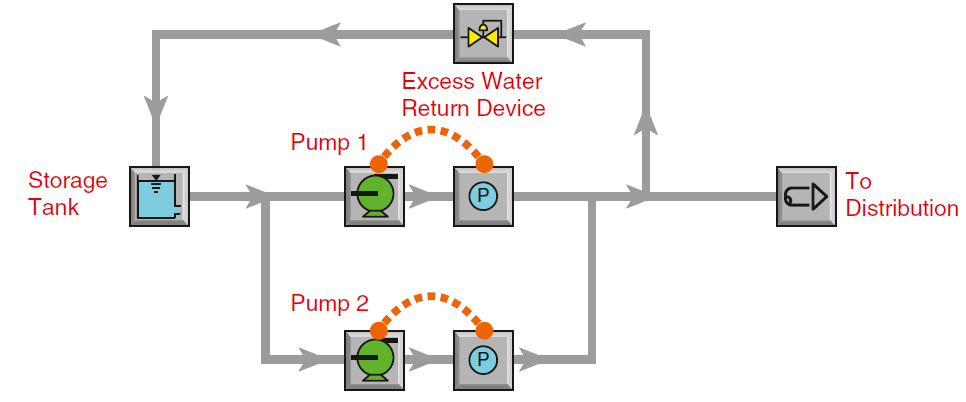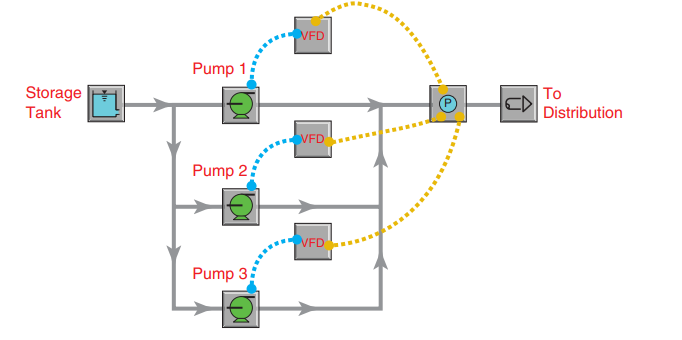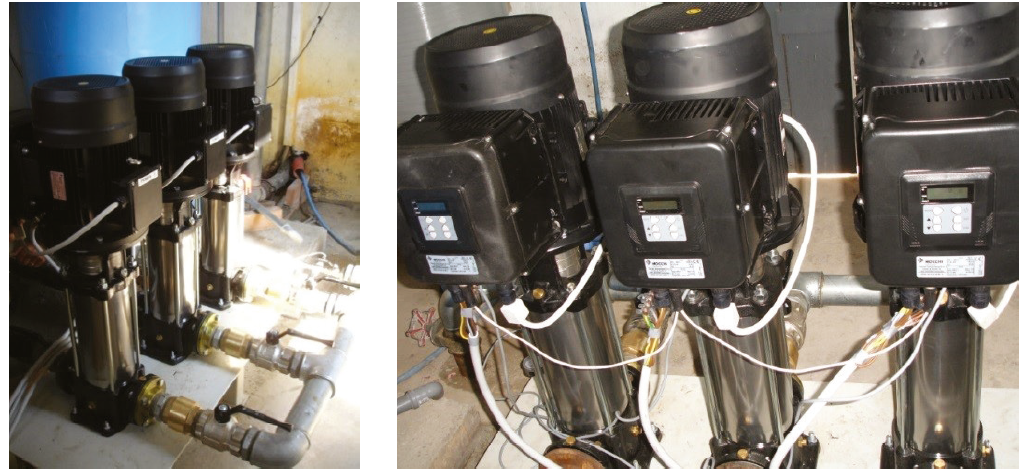Improving Booster Pump Set Efficiency Using Variable Speed Drives
Overview: An existing Booster pump set designed to provide a continuous and steady supply of water to a small community of 40 homes. The initial system utilized two fixed speed pumps operating in an on/off pressure control mode to pump water from a storage tank and maintain water pressure to the community.
Category: Blogs, Case Studies October 17, 2023
Intended Audience: Junior Process Designer, Water Sector, Intermediate Instruction Level
Objective: Improve efficiency and reduce cost of operation while maintaining improved water pressure to the Community.
Description of System: The existing booster pump set system was designed to operate in an on/off mode pumping water from a 1320-gallon storage tank that is replenished by a submersible pump controlled by a level switch. The tank provides sufficient NPSH to the booster set, which is located on ground plane and consists of two pumps controlled by two pressure switches, set to different pressure settings to start up the pumps and when activated the pumps would run at full speed and power. Depending on the demand in the system a flow diversion device was utilized to divert water excess water back to the storage tank which caused the pumps to be fully loaded at all times. See Figure 1.

Figure 1: Original Installation and Control Diagram
Description of Intervention: The fixed speed booster set was replaced with a new VFD-controlled booster set consisting of three vertical multi-stage pumps with on-board VFD control. The VFD’s were connected together utilizing RS485 communication. Each pump was capable of delivering 220 gpm adequate for the installation.
The logic of the control system was designed to ensure the pumps delivered a constant 80 psi of pressure. Two pressure sensors were connected to the control boards to guarantee redundancy. The third VFD was works in a sensorless mode so in the event of failure of one of the sensors, the booster set is able to continue running with two VFD’s in sensorless configuration to maintain pressure. See Figures 2 and 3.

Figure 2: Modified Installation and Control Diagram

Figure 3: New Pumps and Integrated VFD’s
The VFD’s were configured to make full use of the smart functions provided by the controller to save energy and maximize reliability. The number of running pumps and their speed were optimized for best efficiency to maintain constant pressure and immediate availability of water.
The system is designed so that the pups alternate to ensure they accumulate equal operating hours and maximize the mean time between failure. The booster set is able to operate with one pump out of service in the event of maintenance requirements.
The VFD booster system provided enough pressure to compensate for the pressure needs of the houses located on higher elevations and without wasted energy.
A review of the installation costs, energy savings and ROI is provided in Table 1 below:
Table 1: Energy savings and ROI Calculations
| Electricity cost before installation | $21, 500 |
| Electricity cost after installation | $16,000 |
| Electricity cost annual savings | $5,500 |
| Avoided annualized valve maintenance | $500 |
| Total annual savings | $6,000 |
| Project cost | $11,000 |
| Simple payback | 1.8 Years |
| Project life | 10 Years |
| IRR | 54% |
Summary of Results: The new three-pump set with VFD’s provides significant energy savings over the older two pump on/off system. The new system will provide more constant pressure in the water system at a much lower operating cost.
Conclusion: The new installation with use of variable speed technology in conjunction with pressure sensors provided the end user with a more reliable and efficient pumping system reducing annual energy cost by approximately $5500 and reducing maintenance costs by removal of the control valve. Payback for the system will be realized in 1.8 years.
Written by:
The Variable Speed Pumping Committee
Published In: Application Guideline for Variable Speed Pumping Guidebook
Year of Publication: 2017
SUBSCRIBE TODAY
Get the latest pump industry news, insights, and analysis delivered to your inbox.
